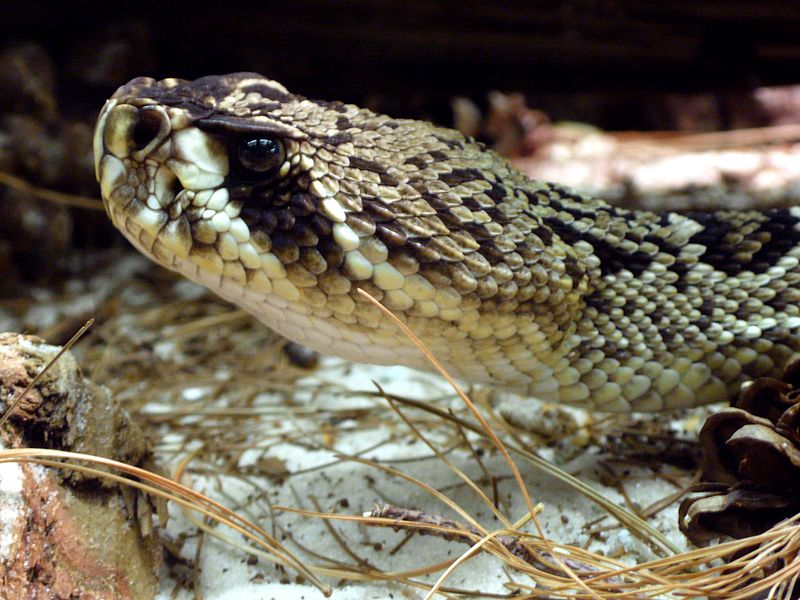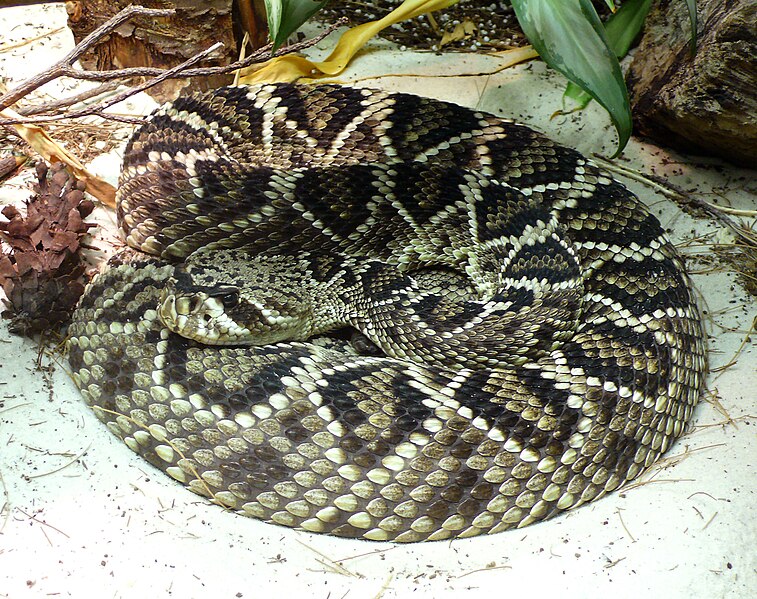 Today I’d like to cover a snake that, while not suitable as a pet, stands out in the minds of many as North America’s most impressive serpent – the Eastern Diamondback (Crotalus adamanteus). In my youth, the nearby Staten Island Zoo’s Reptile House was under the direction of the legendary Carl Kauffeld. The collection contained every known rattlesnake species but, somehow, a massive pair of Eastern Diamondbacks stood apart. Several years ago, I was thrilled to be chosen as consultant for the renovation of this building , and Rattlesnakes, including the Eastern Diamondback, again take center stage there.
Today I’d like to cover a snake that, while not suitable as a pet, stands out in the minds of many as North America’s most impressive serpent – the Eastern Diamondback (Crotalus adamanteus). In my youth, the nearby Staten Island Zoo’s Reptile House was under the direction of the legendary Carl Kauffeld. The collection contained every known rattlesnake species but, somehow, a massive pair of Eastern Diamondbacks stood apart. Several years ago, I was thrilled to be chosen as consultant for the renovation of this building , and Rattlesnakes, including the Eastern Diamondback, again take center stage there.
Description
The record length of this largest of the world’s 33 rattlesnake species is 8 feet, 3 inches; most adults top out at 3-6 feet. In the USA, only the Indigo, Bull, Gopher and Black Rat Snakes approach or, very rarely, exceed this measurement.
The background color of this heavy-bodied, venomous snake ranges from olive through brown to (rarely) near-black. The back is patterned in white-centered dark diamonds that are sharply outlined in cream or yellow.
Captives have lived in excess of 22 years, but longevity in the wild has not been well-studied.
Range
 The Eastern Diamondback is confined to the Southeastern United States, along the lower Atlantic Coastal Plain. It has been recorded in southeastern North Carolina, South Carolina, Mississippi, Alabama, Georgia, Louisiana and Florida (including the Florida Keys).
The Eastern Diamondback is confined to the Southeastern United States, along the lower Atlantic Coastal Plain. It has been recorded in southeastern North Carolina, South Carolina, Mississippi, Alabama, Georgia, Louisiana and Florida (including the Florida Keys).
Habitat
Longleaf pine and sand-hill ecosystems, palmetto and wiregrass prairies and open pine-oak forests are essential to this species’ survival. Unfortunately, only an estimated 2-3% of its original natural habitat remains; consequently, abandoned farms and citrus groves are sometimes utilized. The Eastern Diamondback Rattlesnake shares the longleaf pine (“Flatwoods”) ecosystem with other rare creatures, such as the Flatlands Salamander, Gopher Tortoise, Gopher Frog, Bachman’s Sparrow and Red-Cockaded Woodpecker.
Individuals shelter in Gopher Tortoise burrows, saw palmetto thickets and beneath tree stumps, and may establish home ranges of up to 500 acres.
Except at the southern tip of its range, the Eastern Diamondback Rattlesnake retreats underground as winter approaches. It often utilizes Gopher Tortoise burrows, and emerges to bask on warm days.
Status
 This species is in severe decline due to habitat loss and collection for the skin, novelty and meat trade. Untold numbers have been killed during “rattlesnake roundups”, which are still a tradition in some areas. Gasoline is often poured into burrows (which are also critical habitat for Gopher Tortoises, Gopher Frogs and other species) to facilitate snake collection. Gasoline renders the burrows unusable for several years. Fortunately, there has been at least some movement towards stopping these events; please see the article below.
This species is in severe decline due to habitat loss and collection for the skin, novelty and meat trade. Untold numbers have been killed during “rattlesnake roundups”, which are still a tradition in some areas. Gasoline is often poured into burrows (which are also critical habitat for Gopher Tortoises, Gopher Frogs and other species) to facilitate snake collection. Gasoline renders the burrows unusable for several years. Fortunately, there has been at least some movement towards stopping these events; please see the article below.
The Eastern Diamondback is not federally protected. However, spurred by a Center for Biological Diversity lawsuit filed in 2011, the US Fish and Wildlife Service is currently evaluating the species for inclusion on the Endangered Species List; please see article below.
North Carolina protects the Diamondback, but it may already be extinct there. Several states consider it “Of Special Concern”, but offer no legal protection. A CITES listing has been proposed, and the IUCN designation is “Least Concern”.
Reproduction
The young, 7-29 in number, are born alive from July through October, and measure 12-15 inches at birth. Females generally give birth every 2-3 years, depending upon their diet and condition. Sexual maturity is reached in 2-4 years.
Diet
This “sit-and-wait” predator consumes rice rats, pocket gophers, cotton rats, squirrels, deer mice, chipmunks, rabbits, raccoons, opossums, feral cats and other mammals; birds are also taken on occasion.
Rattlesnake Biology
 Rattlesnakes and other “pit vipers” are placed in the subfamily Crotalinae, along with palm vipers, copperheads, cottonmouths and related species. Considered to be the most highly evolved of the snakes, pit vipers possess a highly sophisticated organ that detects the infra-red rays produced by birds and mammals. Located in a depression between the eye and nostril, it is far more sensitive than similar organs possessed by boas and pythons, and may be considered more of an “imaging device” than mere heat receptor.
Rattlesnakes and other “pit vipers” are placed in the subfamily Crotalinae, along with palm vipers, copperheads, cottonmouths and related species. Considered to be the most highly evolved of the snakes, pit vipers possess a highly sophisticated organ that detects the infra-red rays produced by birds and mammals. Located in a depression between the eye and nostril, it is far more sensitive than similar organs possessed by boas and pythons, and may be considered more of an “imaging device” than mere heat receptor.
Rattlesnakes, confined to the Western Hemisphere, reach their greatest diversity in the American Southwest and Mexico, with 13 of the 33 known species occurring in Arizona alone.
The rattle, unique among snakes, is composed of a series of loosely-connected segments. Specialized muscles in the tail vibrate the rattle so as to produce the characteristic warning sound. The Santa Catalina Rattlesnake, confined to the island of the same name, is the only species that lacks a rattle.
Rattlesnakes and other vipers have evolved hinged fangs that fold back against the roof of the mouth, within a sheath, when not in use (please see photo). Venom is injected in the manner of a hypodermic needle.
All rattlesnakes bear live offspring, and several species appear to provide a degree of parental care. The Black-Tailed Rattlesnake has been shown to recognize siblings after a 2 year separation. Please see the article below for further information on rattlesnakes.
Further Reading
Rattlesnake Roundup “toned down”
Crotalus Fangs image referenced from wikipedia and originally posted by FinneJager
 That Reptile Blog – Reptile, Amphibian and Exotic Pet Care and Information
That Reptile Blog – Reptile, Amphibian and Exotic Pet Care and Information



About 35 to 40 years ago on Amelia Island, I lived near the public dump when it closed. The dump was adjacent to a tidal marsh with several freshwater springs nearby, so there were large populations of rabbits and rats. The biggest rattler I recall ever seeing stretched across the dirt road used by the dump trucks. The head was past one track and the tail across the other. I had nothing to measure and the snake was pretty uncooperative when I tried to get closer. We killed a number of snakes more than 6 feet in length, but this was, by far, the biggest.
I see online a number of statements regarding legendary snakes and an official record of 8’3″. I’m writing because you appear to be something of an authority on snakes. Is it possible for a snake to grow this large near a dump with an unlimited supply of water and food for 30 or 40 years. The dump was in use from the late 30’s until the early 70’s.
Hello Ed,
Thanks for the interesting observation. The habitat you describe, semi natural, mostly undisturbed and with high prey populations, would be likely to produce large individuals,. Technically, reptiles can continue to grow throughout their lives, although the rate is greatly reduced over time. On occasion, one sees individuals that greatly exceed the norm, such as the 92-94 pound Florida softshelled turtle captured 10 or so years ago. The accepted record size of an E Diamondback has long been 8.0 feet; the reference is in this report, under “Species Description”. I’ve not checked for recent updates, but 8′ 3″ would seem possible. Of course, a good deal of nonsense on the net as well. Best, Frank
Hi Frank,
Thanks for this amazing information. I really have been enjoying all you posts.
Much appreciated Lorri,
I hope all is well…will I see you at the meeting on the 9th?
hello very interesting post.
and i have a question . i actualy live in southern mexico colse to Acapulco its a a small town called mezcala and this is the secon time ibe seen a huge diamondback snack near the river it is about 7 feet long and is
verry agresive its hard to get colse to it.
is this normal or is it one bigg snacke ????
regards
Enrique Prado Ortiz
service tech heavy equipment
mobil 52 7474595882
office 52 7331110042
Hello,
Thanks for the kind words. The Western Diamondback ranges into southern Mexico…they have not been reported at that size, but snake size is notoriously difficult to estimate, even after many years of experience. Mexico has more reptile and amphibian species than any country of similar size (as far as we know), and there are several other species that are somewhat similar to the western diamondback; if you’re out and about often, it would be useful to pick up a good field guide to Mexico’s reptiles.
Please keep me posted, best, Frank
Hi Frank.
Question about that “sibling recognition” in C. molossus (Blacktail rattlesnake)– who observed this behavior and did she/he publish the account? We’d love to read about it and include the info when people ask us about “poisonous” snakes during our educational events.
Hi Becky,
This article gives a good account; original articles are listed in the reference section (most published in journals, usually available through libraries but not online). I have others posted on venomous snakes..please let me know if you need links or have any questions. Enjoy, Frank
Thanks for the link. 🙂 We’re lucky enough to work with a very active C. horridus researcher here in western NY, so we field a lot of questions about pit vipers in general. Sometimes I look back and laugh that the terrified 8 year old that screamed for Daddy after she jumped over an equally terrified eastern hognosed snake would end up getting people over their irrational fear of wild reptiles one meeting with a S. sulphureus at a time.
My pleasure…hognosed snakes fool adults also! Best, Frank